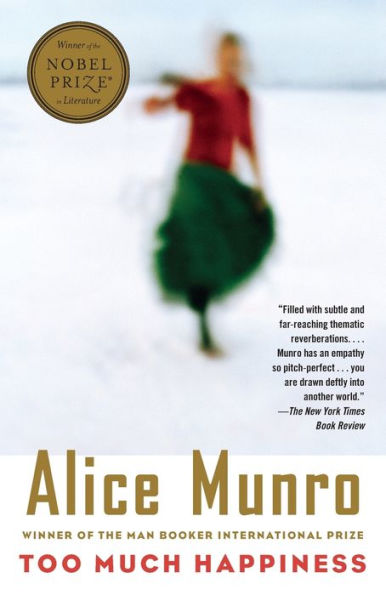Too Much Happiness
A “profound and beautiful” (Francine Prose, O: The Oprah Magazine) collection of ten stories from Nobel Prize–winning author Alice Munro
“Filled with subtle and far-reaching thematic reverberations. . . . Munro has an empathy so pitch-perfect . . . you are drawn deftly into another world.”—The New York Times Book Review
A BEST BOOK OF THE YEAR: The New York Times Book Review, The Atlantic Monthly, The Boston Globe, Los Angeles Times, San Francisco Chronicle, Chicago Tribune, Kansas City Star, The Economist, Slate
With clarity and ease, Alice Munro renders complex, difficult events and emotions into stories about the unpredictable ways in which men and women accommodate and often transcend what happens in their lives.
In the first story, a young wife and mother, suffering from the unbearable pain of losing her three children, gains solace from a most surprising source. In another, a young woman, in the aftermath of an unusual and humiliating seduction, reacts in a clever if less-than-admirable fashion. Other tales uncover the “deep-holes” in a marriage, the unsuspected cruelty of children, and, in the title story, the yearnings of a nineteenth-century female mathematician.
1100258902
“Filled with subtle and far-reaching thematic reverberations. . . . Munro has an empathy so pitch-perfect . . . you are drawn deftly into another world.”—The New York Times Book Review
A BEST BOOK OF THE YEAR: The New York Times Book Review, The Atlantic Monthly, The Boston Globe, Los Angeles Times, San Francisco Chronicle, Chicago Tribune, Kansas City Star, The Economist, Slate
With clarity and ease, Alice Munro renders complex, difficult events and emotions into stories about the unpredictable ways in which men and women accommodate and often transcend what happens in their lives.
In the first story, a young wife and mother, suffering from the unbearable pain of losing her three children, gains solace from a most surprising source. In another, a young woman, in the aftermath of an unusual and humiliating seduction, reacts in a clever if less-than-admirable fashion. Other tales uncover the “deep-holes” in a marriage, the unsuspected cruelty of children, and, in the title story, the yearnings of a nineteenth-century female mathematician.
Too Much Happiness
A “profound and beautiful” (Francine Prose, O: The Oprah Magazine) collection of ten stories from Nobel Prize–winning author Alice Munro
“Filled with subtle and far-reaching thematic reverberations. . . . Munro has an empathy so pitch-perfect . . . you are drawn deftly into another world.”—The New York Times Book Review
A BEST BOOK OF THE YEAR: The New York Times Book Review, The Atlantic Monthly, The Boston Globe, Los Angeles Times, San Francisco Chronicle, Chicago Tribune, Kansas City Star, The Economist, Slate
With clarity and ease, Alice Munro renders complex, difficult events and emotions into stories about the unpredictable ways in which men and women accommodate and often transcend what happens in their lives.
In the first story, a young wife and mother, suffering from the unbearable pain of losing her three children, gains solace from a most surprising source. In another, a young woman, in the aftermath of an unusual and humiliating seduction, reacts in a clever if less-than-admirable fashion. Other tales uncover the “deep-holes” in a marriage, the unsuspected cruelty of children, and, in the title story, the yearnings of a nineteenth-century female mathematician.
“Filled with subtle and far-reaching thematic reverberations. . . . Munro has an empathy so pitch-perfect . . . you are drawn deftly into another world.”—The New York Times Book Review
A BEST BOOK OF THE YEAR: The New York Times Book Review, The Atlantic Monthly, The Boston Globe, Los Angeles Times, San Francisco Chronicle, Chicago Tribune, Kansas City Star, The Economist, Slate
With clarity and ease, Alice Munro renders complex, difficult events and emotions into stories about the unpredictable ways in which men and women accommodate and often transcend what happens in their lives.
In the first story, a young wife and mother, suffering from the unbearable pain of losing her three children, gains solace from a most surprising source. In another, a young woman, in the aftermath of an unusual and humiliating seduction, reacts in a clever if less-than-admirable fashion. Other tales uncover the “deep-holes” in a marriage, the unsuspected cruelty of children, and, in the title story, the yearnings of a nineteenth-century female mathematician.
18.0
In Stock
5
1

Too Much Happiness
320
Too Much Happiness
320Paperback(Reprint)
$18.00
18.0
In Stock

Product Details
| ISBN-13: | 9780307390349 |
|---|---|
| Publisher: | Knopf Doubleday Publishing Group |
| Publication date: | 11/02/2010 |
| Series: | Vintage International |
| Edition description: | Reprint |
| Pages: | 320 |
| Sales rank: | 66,069 |
| Product dimensions: | 5.10(w) x 7.90(h) x 0.80(d) |
About the Author

From the B&N Reads Blog
